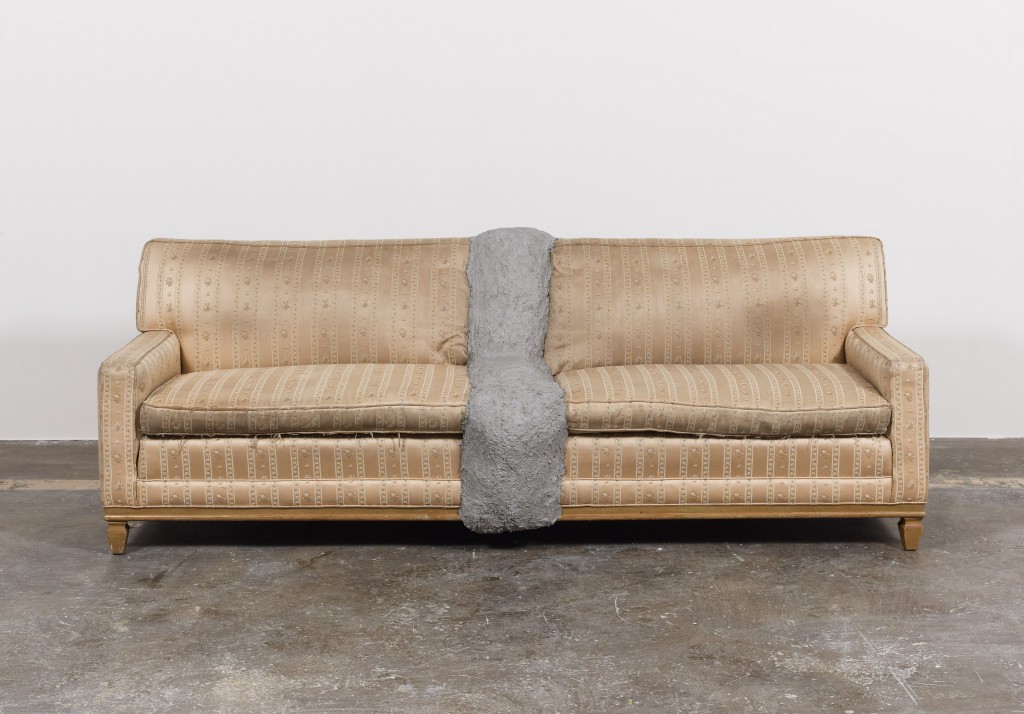
Rodney McMillian. Couch, 2012. On view at the Studio Museum.
Couch and cement, 32 1/2 × 88 1/2 × 33 1/2 in. Courtesy of the artist and Maccarone, New York/Los Angeles.
To experience Rodney McMillian’s work is to be overcome by a feeling of absence. A genius of poetic abjection, McMillian repurposes disused domestic materials to suggest personal and social histories, evoking a bygone human presence that is only discernible through scant, abstract traces. In a way, this idea of absence might unify McMillian’s practice, which includes works loosely categorized as sculptures and paintings as well as performances and videos that use human proxies to reenact historical moments fraught with racism and demagoguery. No matter the format of his work, however, his politics and aesthetics are inextricable and utterly timely.
In a pair of exhibitions currently on view in New York, viewers can experience a wide sample of the incisive and prolific artist’s oeuvre. Views of Main Street at the Studio Museum in Harlem offers a broad overview of McMillian’s work from the past decade, including sculptures, paintings, and videos. At MoMA PS1, the smaller and more focused Landscape Paintings (organized by the Aspen Art Museum) features a dozen abstract paintings made from brightly colored latex and used bed sheets. Taking into account a third exhibition currently on view, The Black Show at the Institute of Contemporary Art in Philadelphia, the Los Angeles–based McMillian is enjoying a moment in the local spotlight. It might be reductive to suggest his racial politics are more relevant now than in years past, but the contemporary cultural climate nonetheless makes his project all the more pressing.
Rodney McMillian. Untitled, 2009. On view at the Studio Museum.
Chair, cardboard tube, and latex paint, 87 × 33 × 29 in.
Courtesy the artist and Maccarone, New York/Los Angeles. Photo by John Kennard, courtesy Susanne Vielmetter Los Angeles Projects.
The sculptures in Views of Main Street figure the domestic realm as a place where intimacy, family, and personal identity intersect with broader issues of class, race, and neoliberal policy. While his materials lend an air of familiarity, McMillian destabilizes and undermines this appearance with dramatic physical transformations. In the unforgettable Untitled (2009), he has impaled a familiar IKEA chair with a giant black tube—evoking a sort of industrial-scale phallus enacting sexual violence against a mainstay of bourgeois décor. For Couch (2012), he severed a sateen sofa and pasted it together with a thick band of cement. Other material interventions are subtler but equally haunting, like the wonderful Chair and Books (2004), in which a bridge of used paperbacks links two thoroughly worn armchairs. Like many of his best sculptures, it evokes a complicated mix of poverty and marginalization, as well as survival and humble self-making in the face of these factors.
A handful of wall hangings at the Studio Museum, made from deliciously dated linoleum and wall-to-wall carpet bearing the evidence of decades of use, stand in direct conversation with McMillian’s large paintings on view across the East River at MoMA PS1. It’s not immediately obvious that the bed sheets for these works were previously used and purchased at thrift stores, but this knowledge certainly colors our interpretation of them. The works’ expressionistic pours and sticky splotches read almost like bodily fluids dried into or spilling out from the cheap fabric. The paintings ensnare the viewer in a place between fascination and revulsion, their visceral abstract beauty intersecting with the voyeuristic pleasure of imagining all the sleeping, sweating, and screwing that was done in these very sheets.
Rodney McMillian. Untitled (tongue). 2014. On view at MoMA PS1.
Latex on bed sheet, 100 x 70 in.
Courtesy the artist and Susanne Vielmetter Los Angeles Projects.
The two New York exhibitions cast the works as commentaries on racial and socioeconomic inequality, but in fact McMillian’s best pieces derive their power from an irrepressible core of ambiguity; it leaves them readily adaptable to politics but equally open to other aesthetic, narrative, and personal associations. In his brilliant video works on view at the Studio Museum, however, there is no such indeterminacy. Especially pointed is Dummies on a Porch Swing (2012), in which two puppets swing casually to the soundtrack of an infamous tape of Lee Atwater, leaked in 1981, in which the prominent strategist discusses how overt racism has been transformed into coded political maneuvers like tax cuts and slashed social services that have disproportionate effects on black communities. The theme is picked up in Neshoba County Fair (2012), wherein a cast of Muppet-like marionettes reenacts one of Ronald Reagan’s notorious race-baiting speeches delivered under the guise of states’ rights. More overt than the paintings or sculptures in their politics, these videos inevitably affect one’s take on the works in other media. The cast-off armchairs and worn textiles start to seem like pieces of evidence of these exclusionary politics—the videos’ rhetoric made real.
By presenting rather than representing, exposing rather than obscuring, McMillian’s work might seem in direct opposition to the idea of illusion. While this might be true of the work itself, McMillian accomplishes the great feat of destabilizing many of the illusions our society relies on for its survival. We consider our private spaces to be sacred, but they are not isolated from the racist rhetoric and policies that come from the top of the political order. Our leaders assure us that we have come a long way, but racism and inequality persist to this day in ever-evolving ways. McMillian shows us that progress—like comfort, safety, and stability—is an illusion.
Rodney McMillian. Blue sun, 2014‑2015. On view at MoMA PS1.
Latex and ink on bed sheet, 95 × 86 in.
Collection of Danielle and David Ganek.
Rodney McMillian: Views of Main Street is on view March 24–June 26 at the Studio Museum in Harlem.
Rodney McMillian: Landscape Paintings is on view April 3–August 29 at MoMA PS1.